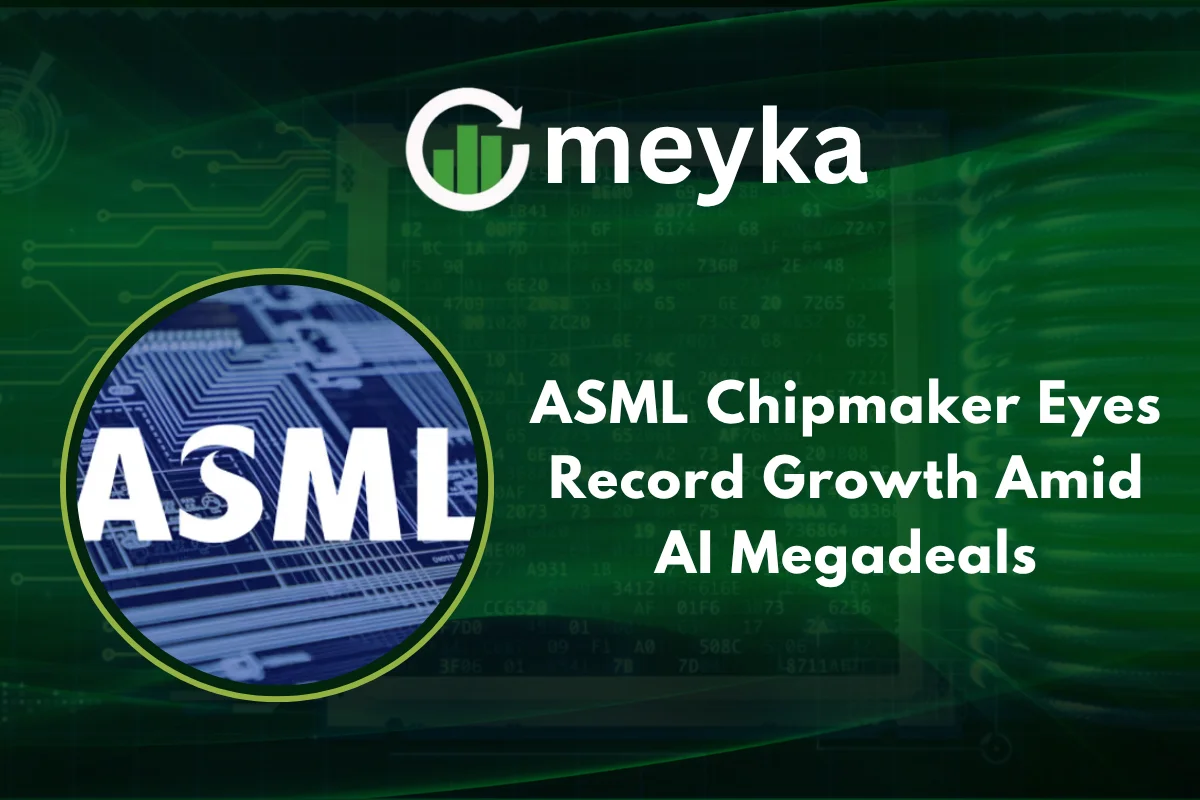ASML Chipmaker Eyes Record Growth Amid AI Megadeals
In an era defined by artificial intelligence, ASML chipmaker, is emerging as a central player in the global semiconductor boom. As AI firms strike multibillion-dollar deals with leading chipmakers, demand for ASML’s advanced lithography machines is accelerating.
The Unique Role of ASML in the Semiconductor Value Chain
ASML Holding N.V. is a Dutch technology firm that designs and manufactures photolithography equipment essential to producing advanced chips. It is the world’s only supplier of cutting-edge extreme ultraviolet (EUV) lithography tools used in the latest nodes.
These machines are critical when chipmakers move from, say, 7 nm down to 3 nm or beyond. No competitor matches ASML’s technological barrier in this domain. That gives ASML a moat, not just in hardware but in recurring service, upgrades, and partnerships.
Because advanced AI chips demand the highest performance, chip designers must push complexity, more transistors, finer features, multi-patterning, and often multiple EUV exposures per layer. ASML stands at the pivot of that requirement.
AI Megadeals Fuel Surge in Demand
Massive AI investments translate to new orders
Tech giants, cloud providers, and hyperscalers are signing mega deals for infrastructure expansion. These deals often include commitments to build new data centers, expand capacity, or commission custom chip development. That sends ripples down to chip foundries like TSMC, Intel, Samsung, and memory vendors like SK Hynix and Micron. These firms, in turn, place orders from ASML for the tools needed to build advanced logic and memory wafers.
Analysts now expect ASML to report new bookings in the third quarter of around €5.36 billion, reflecting strong alignment between AI tailwinds and hardware demand.
EUV growth projections are bullish
ASML forecasts around 30 % growth in EUV sales in 2025, driven by continued investment in AI and memory. Yet ASML’s outlook for 2026 remains cautious; geopolitics, macro volatility, and supply constraints introduce uncertainty.
Strategic pivot: AI + hardware synergy
In a bold move, ASML invested €1.3 billion in French AI startup Mistral AI, becoming its largest shareholder (~11 %).
This partnership aims to embed AI models across ASML’s products, optimizing throughput, yield prediction, and cycle time. It also positions ASML not just as a hardware supplier but as a software-infused systems company.
What Growth Could Look Like: Forecasts and Bridge to Reality
- Revenue and margin expansion: Analysts expect ASML’s 2025 revenue to grow ~15–25 % year over year, with upward revisions as bookings strength shows.
- Longer-term goals: Some projections suggest ASML might aim for €44–60 billion in annual sales by 2030, with gross margins in the 56–60 % range.
- Backlog and delivery schedules: Lead times for these machines often stretch months or years. Even booked orders must survive execution risk, supply chain constraints, or reorder changes.
- Geopolitical & export risks: ASML faces regulatory pressure. Import/export restrictions, especially to China, could throttle growth.
If ASML executes well on capacity expansion, supply chain integration, and software enhancements, it could register one of its strongest growth phases ever.
Implications for AI Stocks & Stock Market Investors
ASML as an “AI stock” play
While ASML is not a pure AI company, its critical role places it firmly in AI stock discussions. It acts as the hardware backbone enabling AI scaling. As AI-related infrastructure gets prioritized, ASML stands to benefit broadly, not just from one chip design or vendor, but from the whole AI ecosystem.
Relative positioning among chip & semiconductor stocks
Compared to chip designers like Nvidia or AMD, ASML’s business is less volatile to single product cycles. But its exposure to capital spending cycles can make it more susceptible to macro swings. For diversified stock research, ASML provides a mix of defensibility and cyclicality.
Stock valuation & investor attention
Investors and analysts have raised expectations. Some anticipate earnings per share growth of 14–25 % this year, which could draw more capital into the stock. ASML’s premium valuation is justified in some eyes by its unique position, but it still depends on execution and macro stability.
ASML’s stock has already rallied ~32 % since September, outpacing many peers in the semiconductor sector.
Risks to Watch & Downside Scenarios
No growth story is without caveats. Key risks to monitor include:
- Execution delays: Manufacturing, component shortages, or logistical delays could hamper deliveries, leading customers to shift orders or delay capital commitments.
- Order cancellations or postponements: If AI spending slows or macro conditions worsen, chipmakers may delay spending, affecting ASML’s backlog.
- Geopolitics & export controls: Restrictions, especially around China, could limit addressable markets or impose compliance burdens.
- Overvaluation and sentiment shifts: High expectations increase the risk of sharp corrections if growth misses guidance.
- Competition & innovation leaps: While ASML currently dominates in EUV, breakthroughs elsewhere or new entrants (especially from China) could erode its moat over time.
Conclusion
ASML chipmaker stands at the intersection of the AI boom and semiconductor innovation. With deep technical advantages, strategic moves into AI, and a surging order pipeline, it has the potential to deliver record growth. But much depends on execution, external macro and policy factors, and maintaining its edge.
For investors seeking exposure to the AI hardware boom beyond chip designers, ASML is a compelling option, one that links the infrastructure demands of the AI revolution directly to the stock market. In stock research, ASML may serve as both a barometer and a beneficiary of AI’s next phase.
FAQs
ASML builds the photolithography machines, especially EUV tools, that enable the fabrication of advanced chips with dense, precise circuits. Without such tools, leading-edge AI chips at 3 nm or smaller can’t be manufactured at scale.
Yes. ASML’s strength is in supplying many foundries and memory firms. Even if a specific chip design falters, broad demand across the semiconductor supply chain offers resilience.
Absolutely. Export controls, especially those targeting China, or new trade policies could restrict markets or slow deployments, a key risk to consider in any AI stocks thesis.
Disclaimer:
This content is made for learning only. It is not meant to give financial advice. Always check the facts yourself. Financial decisions need detailed research.






